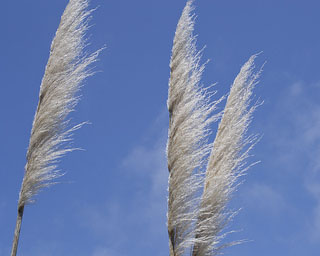 Explore the Native Plant Program's “Don't Plant Me!” pages
Explore the Native Plant Program's “Don't Plant Me!” pages
California hosts approximately 1,100 species, subspecies, and varieties of plants that did not naturally occur in the state, but have become naturalized and continue to reproduce in the wild. Of these, approximately 183 are currently listed on the Pest Ratings of Noxious Weed Species and Noxious Weed Seed (PDF) developed by the California Department of Food and Agriculture, which categorizes them as invasive plants capable of damaging the environment and economy of our state. Other non-native plants have not yet been introduced into California, and some are already in California and still have the potential to become invasive. Invasive plants not only crowd out crops, degrade rangeland, increase the potential for wildfire and flooding, consume valuable water, and degrade recreational opportunities, but they also pose a serious threat to California’s native plant species. Invasive plants tend to out-compete California’s native flora for resources such as space, light, water, and nutrients, are sometimes avoided by animals which can cause an increase in pressure on native plants, and can entirely replace natural vegetation communities. In fact, one of the most drastic changes of plant community dominance in the world occurred in California’s Central Valley.
California’s Central Valley
Few areas have had their vegetation so completely altered as California’s Central Valley (Mack 1989). The invasion of non-native plants began in 1769 with Spanish settlement. Evidence of invasive plants has been found within the old adobe bricks of the Spanish missions along the California coast (Hendry 1931). Although weeds may have been spread by Spanish livestock during this time, the introduction and spread of invasive plants into California exploded with the flood of human immigration after the discovery of gold in 1848. Invasive plants were likely introduced through contaminated seed lots, imported forage, and packing materials. Remaining native vegetation of the Central Valley was so trampled and devastated by the flood of livestock that even more invasive plant species were deliberately introduced as forage. The extreme pressures from livestock, competition with invasive plants, natural flooding, drought, and cultivation of much of the Central Valley all led to the rapid transformation of the Central Valley’s vegetation. By 1880, the Central Valley was almost completely transformed into a non-native annual grassland (Mack 1989). Since that time, the vegetation has been exposed to additional waves of plant invasion. Although perennial grasses are believed to have been much more prevalent before these invasions, little information about the native species composition of the Central Valley currently exists. As a result, botanists can’t be certain of the plant species composition of California’s Central Valley before it was overrun by invasive plants.
Threatened and Endangered Species
The spread of invasive plants is one of the most significant threats to the native plant species and vegetation communities of the state, second only to habitat destruction. Threatened and endangered species are particularly vulnerable to the pressures of invasive plants. A sample of U.S. Fish and Wildlife Service recovery plans showed that 73 percent of the threatened and endangered species reviewed are threatened by exotic species (Lawler 2002). Many of California’s most imperiled species occur in close proximity to human development, and with development comes invasive plants. These invasive plants encroach upon the last bastions of many endangered plant species and could be the final straw driving them to extinction. The control and prevention of invasive plant infestations is of the utmost importance for maintaining the biodiversity of California and preventing the extinction of rare, threatened and endangered plant species.
References
- Hendry, G.W. 1931. The adobe brick as a historical source. Agric. Hist., 5, 110-27.
- Lawler JJ, Campbell SP, Guerry AD, et al. 2002. The scope and treatment of threats in endangered species recovery plans. Ecol Appl 12: 663–67.
- Mack, R. N. 1989. Temperate grasslands vulnerable to plant invasion: Characteristics and consequences. In: Biological Invasions: A Global Perspective. (J. Drake, ed.) pp. 155-179. Wiley and Sons, New York.